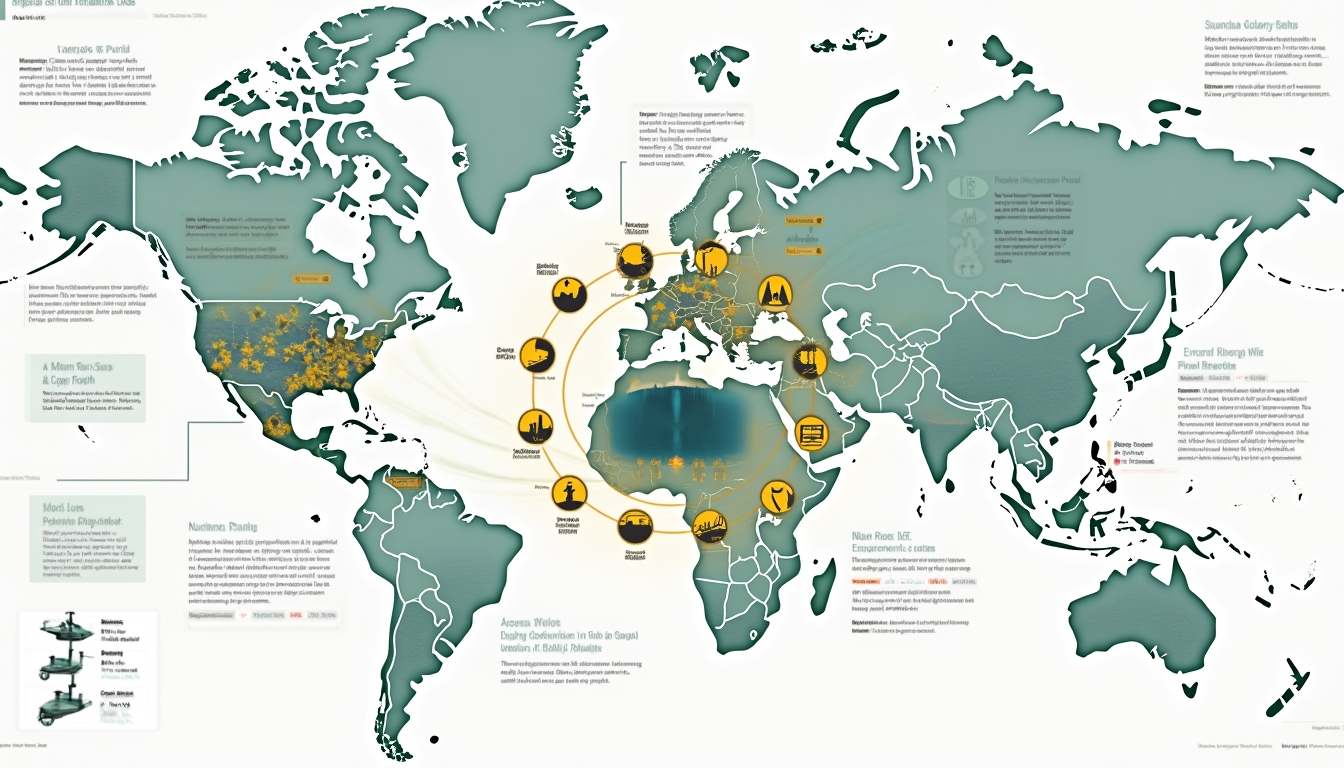Critical minerals represent the foundational resources powering modern technological infrastructure, playing a pivotal role in transforming global economic and strategic landscapes. With an emphasis on securing critical mineral supply chains, nations worldwide are exploring innovative approaches to reduce reliance on traditional sources, bolster technological progress, and enhance their industrial competitiveness. Securing critical mineral supply chains remains a priority as governments and industries work together to overcome market challenges and regulatory hurdles.
What Are Critical Minerals and Why Do They Matter?
Critical minerals are rare earth elements and strategic metals with extraordinary technological significance and limited global availability. Their importance stems from enabling cutting-edge innovations in electronics, green technologies, and national security infrastructure. With diverse applications in several key sectors, these minerals are integral to driving global progress. Key sectors fundamentally dependent on critical minerals include:
- Electric vehicle battery production
- Renewable energy technology
- Advanced semiconductor manufacturing
- Defense and aerospace systems
- High-performance computing
As modern economies expand, the need for securing critical mineral supply chains becomes ever more important. Ensuring resilient access to these resources helps prevent supply disruptions that could derail economic growth or compromise national security.
How Dominant is China in Critical Mineral Supply Chains?
For decades, China has systematically established near-total dominance in critical mineral supply chains, leveraging strategic resource acquisition and efficient processing capabilities. Market statistics illustrate this dominance:
- 90% control of rare earth mineral processing
- Approximately 80% of the global production of strategic battery minerals
- Comprehensive vertical integration from extraction to refined product manufacturing
This overwhelming market position has prompted global concern and strategic responses. In response to these challenges, new policies addressing china export restrictions have emerged, as various countries attempt to rebalance the economic scales while ensuring their own supply chain security.
What Challenges Prevent Western Mineral Independence?
Western nations face numerous hurdles when it comes to achieving mineral self-sufficiency. Several significant challenges include:
- Protracted permitting processes that can average 29 years – discouraging timely development.
- High market volatility which deters long-term investments, leaving industries vulnerable to sudden supply shocks.
- Limited domestic processing infrastructure – a gap that prevents industry players from refining raw minerals locally.
- Complex regulatory environments that complicate both exploration and extraction processes.
These issues are compounded by the difficulties in establishing efficient supply chains and securing critical mineral supply chains across diversified markets. As a result, policy reforms and government interventions have become central to overcoming these obstacles.
Strategic Approaches to Improve Supply Chain Resilience
Building a robust and resilient mineral supply ecosystem requires innovative and collaborative strategies. Industry experts have suggested various approaches to enhance supply chain security:
- Implementing targeted government incentives, such as critical minerals tax incentives, to stimulate domestic investment.
- Developing strategic international partnerships that support resource diversification, moving away from heavy reliance on any single country.
- Creating robust domestic processing capabilities, as local refinement can reduce dependency on foreign markets.
- Establishing multi-year investment frameworks that offer long-term security to projects.
- Diversifying international mineral sourcing networks to hedge against country-specific supply risks, an approach mirrored in recent initiatives aimed at diversifying mineral supply chains.
In addition, engaging with global policy institutions can offer valuable perspectives. For instance, insights into reliable supply strategies highlight how structured policy frameworks can attenuate market disruptions.
How Can Allied Nations Collaborate on Mineral Security?
Multinational cooperation is emerging as a critical pathway toward reinforcing supply chain resilience. Collaboration among allied nations can manifest in different forms:
- Strengthening North American resource cooperation through shared research and development.
- Establishing joint mineral processing facilities to collectively manage refining and production capacities.
- Developing shared technological research initiatives that address the challenges of extraction and processing.
- Formulating preferential trade agreements to ease the flow of strategic minerals between nations.
Such concerted efforts not only help in securing critical mineral supply chains but also help distribute risk more equitably among major economies. These partnerships are often further bolstered by proactive government support measures, ensuring policy continuity and operational consistency.
Beyond regional partnerships, international organisations are also engaging with defence and energy sectors. According to recent reports, mineral security inputs and innovative frameworks reinforce the idea that safeguarding critical resources is tantamount to national security.
Policy Reforms Needed to Enhance Mineral Supply Chains
Substantial policy reforms are necessary for countries to effectively enhance their mineral independence. Key policy recommendations include:
- Streamlining complex permitting processes to reduce approval timelines and attract investment.
- Providing long-term investment guarantees that can mitigate market instability.
- Developing government-backed pricing mechanisms to ensure fair market returns for investors.
- Creation of strategic national mineral stockpile programmes to buffer against sudden shortages.
- Incentivising domestic exploration and processing by offering favourable tax and regulatory treatments.
These reforms contribute directly to the broader goal of securing critical mineral supply chains. In the long run, such policies will foster a resilient market environment where technological innovation and economic growth can thrive. Moreover, they serve to reduce reliance on volatile international markets, thereby stabilising the supply chain over time.
Mining and Economic Opportunities: A Transformative Shift
The mining sector is undergoing a transformative shift, with increasing emphasis on tailings reprocessing and the recovery of minerals from waste streams. This approach not only mitigates environmental impacts but also represents a critical source of economic opportunity. The industry is embracing mining economic opportunities through innovative techniques that reprocess tailings – effectively turning waste into valuable resources.
This strategy also dovetails with the commitment to securing critical mineral supply chains, as emphasising resource efficiency reduces the need for new extractions and minimises the environmental footprint of mining operations. Highlights of this transformative shift include:
- Increased recovery rates of strategic minerals from previously discarded waste.
- Reduced reliance on environmentally and politically volatile foreign sources.
- Enhanced profitability through sustainable practices.
- Long-term economic benefits for local communities and associated industries.
A Realistic Timeline for Supply Chain Transformation
Industry experts predict that tangible improvements in supply chain resilience can be achieved within a 10-20 year horizon. This transformation requires:
- Systematic, mineral-by-mineral resilience building across all critical pathways.
- Sustained commitment from a diverse range of stakeholders.
- Significant investments from both public and private sectors.
- Continued technological innovation to drive efficiencies in exploration, extraction, and processing.
As countries continue to prioritise securing critical mineral supply chains, this timeline represents a realistic window to achieve independence from traditional market uncertainties and geopolitical risks. The gradual transformation is expected to yield enhanced national security, reduced environmental impacts, and bolstered economic growth over the coming decades.
Summarised Key Strategies for Securing Supply Chains
To encapsulate the multifaceted approaches discussed in the article, consider the following summary of key strategies:
- Introduce government-backed tax incentives and streamlined regulatory frameworks.
- Promote international collaboration through joint initiatives and partnerships.
- Invest in domestic processing capabilities to reduce reliance on external sources.
- Incorporate innovative recycling and tailings reprocessing methods.
- Leverage policy insights and strategic market forecasts to guide long-term investments.
Each of these points plays a critical role in the overarching strategy of securing critical mineral supply chains, a subject that remains at the heart of achieving both industrial and technological progress.
Conclusion
In summary, securing critical mineral supply chains requires a sophisticated blend of policy reforms, international cooperation, and targeted economic strategies. By addressing the dominance of established players, such as China, and by implementing innovative measures like tailings reprocessing and domestic investment incentives, nations can secure a more stable supply of essential resources. With focused efforts and strategic collaborations, the transformation of mineral supply chains over the next decade will not only bolster economic growth but also reinforce national security in an increasingly competitive global landscape.
Ready to Unlock Critical Mineral Investment Opportunities?
Dive into the world of strategic mineral investing with Discovery Alert's real-time AI-powered notifications, designed to simplify complex market insights and help you identify breakthrough opportunities in critical minerals before they become mainstream. Start your 30-day free trial today and transform your investment strategy with cutting-edge mineral discovery intelligence.







